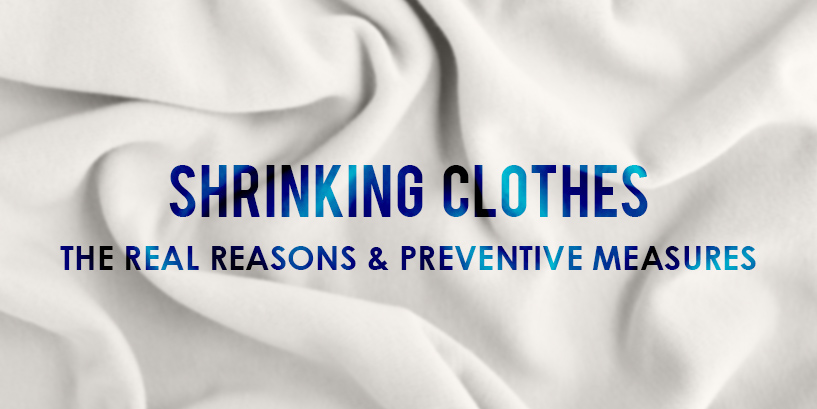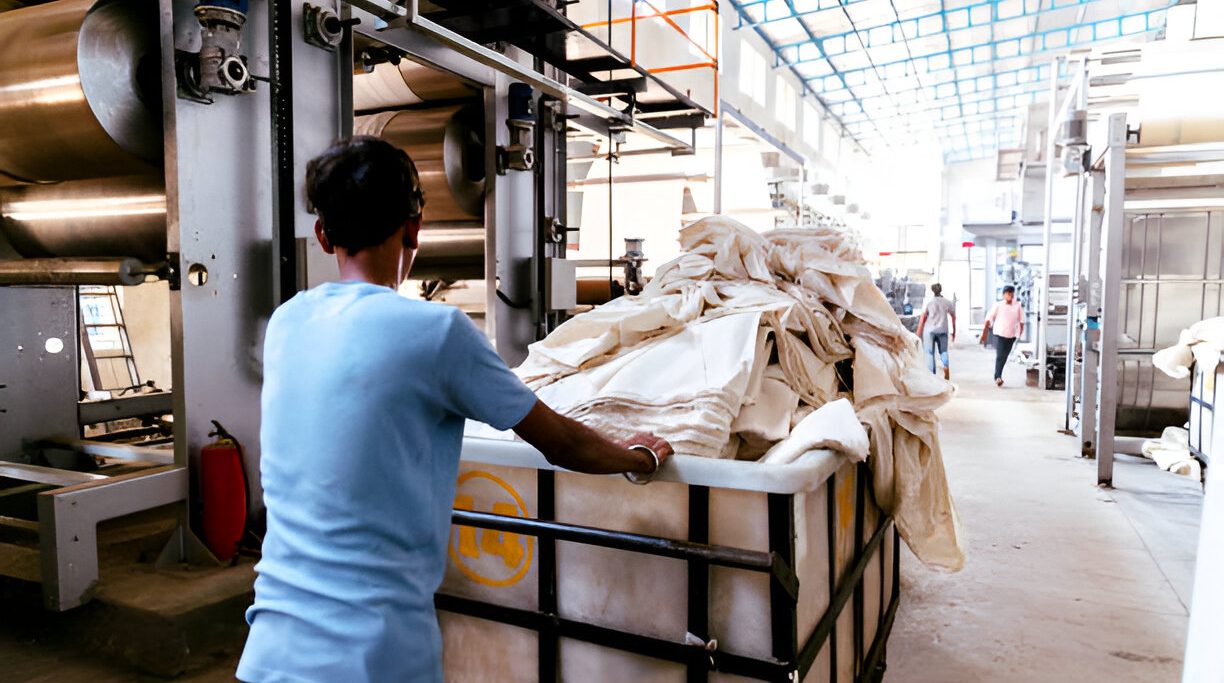Most of the clothing will shrink or expand after use. You cannot avoid this, but you can stall the process to an extent. For that, we should know the reasons behind shrinking clothes.
Why do clothes shrink?
The structure of the fibers is why fabrics shrink. The fiber content, heat applied when washing, agitation, and even the drying process could lead to the shrunken fabric. The technical names for the possible factors are relaxation, felting, and consolidation.
Relaxation
This shrinkage occurs in absorbent fabrics like cotton, linen, or hemp. But it can also occur in other types of fabric. This happens when a fabric is exposed to moisture or steam. When weavers spin the fiber into the fabric, it is held in place by strain and tension. Then the fabric goes through processes called tentering and calendering. This causes further strain on the fabric. But this stretch is a temporary set.
When the fabric is wetted, the fiber soaks up all the moisture and swells as a result. This causes the fibers to relax from the stress it was previously under. And the result is a shrunken garment. But, unfortunately, relaxation shrinkage usually doesn’t result in drastically smaller clothes.
Felting
Felting is a type of shrinkage in clothing derived from animal fur. This includes wool and mohair. These fibers have scales on their surface. This, when exposed to high heat or moisture, will compress. Felting is a type of progressive shrinking. This means that it will shrink every time such fabric is exposed to heat. Felting is the hardest type of shrinkage to reverse.
Consolidation
Consolidation shrinkage happens due to the combined effect of heat, moisture, and agitation. A garment is subjected to all these factors when we wash it. So it is not easy to prevent consolidation shrinkage. This type of shrinkage always has the strongest effect during the first wash cycle. Then, the amount your garment shrinks gets progressively lower.
Swelling
Much like relaxation, swelling shrinkage also occurs due to water. The constant absorption and evaporation of water during a washing cycle cause the fiber to shrink. Again, the swelling effect is greater in a loosely woven fabric than in a higher-quality one.
Contraction
Contraction shrinkage happens when fibers are exposed to temperatures above 210°C. This happens only in synthetic yarns. If the synthetic fibers are heat-set during making fabric, contraction can be fully prevented.
What fabrics shrink the most?
Shrinking happens mostly to natural fabrics like cotton and wool. But synthetics aren’t free from shrinking either—the rate and reason for shrinking changes according to fabric type.
It is no surprise that natural fabrics like cotton, silk, and wool undergo the most shrinkage. This is because they absorb and retain more moisture than synthetic fabrics. But even within natural fabrics, not all of them shrink an equal amount. This is because the fiber make-up for each fabric changes, influencing its shrinks.
Cotton fibers are the most prone to shrinkage. This is followed by other natural fabrics like linen, hemp, and silk. Rayon, a semi-synthetic fabric, is the fabric that shrinks the most. This is because rayon fibers are susceptible to heat. Therefore, it is susceptible to shrinking even in lukewarm temperatures. Viscose, another semi-synthetic fabric, shrinks under heat.
It is hard but not impossible to shrink synthetic fabrics like polyester, acrylic, and rayon. This is because the fibers are chemically created not to shrink. The fibers need to be subjected to very high heat before it shrinks. And luckily, most synthetic fabrics don’t hold wrinkles. So you won’t need to iron them either. But if you do put it in a dryer or leave it out in the sun, there is a chance even synthetics will shrink.
How do I prevent my clothes from shrinking?
It is almost impossible to stop your garments from shrinking. Shrinkage is a natural process that every fiber undergoes. But you can delay the speed of shrinkage.
- Read the wash care instructions.
Every piece of clothing you buy will have a list of instructions to follow when washing and drying. Don’t consider this tag to be a suggestion. It is mandatory to follow what it says if you want your clothes to last. Every piece of clothing has a temperature and wash setting that it can tolerate. Some fabrics react with bleach while others don’t. All this is mentioned on the tag.
You will be most likely to look at the design and style of the outfit before buying it. But from now on, read the wash instructions too. Unfortunately, you can only dry clean some clothes. But not everyone may be able to access dry-cleaning facilities. So reading the tag before buying your clothes might save you from shrinking disasters.
- Sort your clothes
Different fabrics have different washing needs. You’ll know this if you follow step 1. It’s best for your machine and your clothes if you sort them according to the color and washing needs. For example, you can prevent bleeding dyes from coloring your favorite white shirt by sorting colors. Washing delicates separately also gives you control over the washing powder you use.
- Avoid hot water
You may think that your sweaty clothes need a dose of hot water to kill the germs. This can’t be further from the truth. Many people choose hot water because the chemicals from your washing products react better in hot water. But the trade-off here is that your clothes will shrink from the temperature.
The agitation inside a washing machine will also cause clothes to shrink. But this is a condition you cannot avoid. However, you can avoid washing in hot water. Set the default temperature in your washing machine to a cold setting. This way, you won’t accidentally shrink your clothes in the washer. Using the hot water setting in a washing machine will consume more energy. The temperature can also cause stains to set on your clothes. So it’s best all-around if you wash clothes in cold water.
- Follow old-time wash care.
Before washing machines and dryers came around, everyone hand washed and air dried their clothes. And guess what? The clothes lasted longer this way. Even though it may not seem like it, hand washing is gentle on fabrics. Agitation is a major cause of shrinkage for most natural fibers. Also, by hand washing, you can control the detergent and water used for each cloth better than machine wash.
A dyer machine usually blasts your clothes with hot air to dry them quickly. Unfortunately, this takes up much electricity. The high heat also shrinks your clothes. So whenever possible, air-dry your clothes, preferably in the shade. But air-drying is only plausible if you live in an area without constant precipitation and humidity. So in case you are compelled to use a dryer, opt for the air-fluff or tumble-dry setting. This way, your clothes won’t be subjected to high heat.
Another thing you can try is to dry your clothes in the washing machine partially. Then you can finish off the drying process by hang-drying it. One thing you need to avoid while air drying is to leave your clothes drying for a long time. This will also cause your clothes to shrink and the colors to fade. Instead, hang your clothes to dry either earlier in the morning or at night. Then, it can finish drying as the day gets warmer.
- Wash less
Workout clothes and daily wear need to be washed pretty regularly. But the same is not true for all of your clothes. Try to increase the number of wear you get between washes. You can do this by immediately changing out of your outside clothes after getting home. And when you’re changing, be careful to fold or hang your clothes properly. This will prevent your clothes from getting wrinkles, making them wearable the next time.
Washing your clothes, especially the ones that don’t get much wear, will cause the dyes to fade. It will also hasten the shrinking process, ultimately reducing the life of your outfit. Denim can go up to 3-5 wear before being washed. However, if your pants get dirty, throw them in the washer. You don’t need to wash silk as often as other fabrics.
- Shop by fabric
If you don’t want your favorite top to shrink, shop from a fabric that doesn’t shrink easily. Of course, this may not be possible for all of your garments. But wherever possible, try to go for unshrinkable fabric. Mixed fabrics are good options if you’re looking for fabrics that don’t shrink.
You can also shop for pre-shrunk fabrics. Many manufacturers wash the fabric before stitching it. This allows the first to shrink; often, the most fabric shrinks. This way, you won’t have to deal with a drastic size difference.
Fabrics change shape, and that’s inevitable. But with proper TLC, you can extend the life of your favorite shirt.



